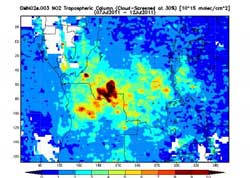NASA's Aura satellite measures pollution 'butterfly' from fires in central Africa

This image from the OMI instrument on NASA's Aura satellite shows nitrogen dioxide levels from July 7 through 12, 2011 in central Africa pertaining to agricultural fires. The highest levels of NO2 appear as a dark red butterfly over the southern Democratic Republic of the Congo. The NO2 is measured by the number of molecules in a cubic centimeter. Credit: NASA/James Acker<br>
An image of the pollution from agricultural fires in central Africa was created from data of nitrogen dioxide (NO2) levels over the period from July 7 to 12, 2011. It was created from Ozone Measuring Instrument (OMI) data using the NASA Giovanni system by Dr. James Acker at NASA's Goddard Space Flight Center in Greenbelt, Md.
Each year, people in the region burn croplands to clear fields after harvests. Burning is also used to create new growth in pastures and move grazing animals to new locations.
NO2 forms during fires when nitrogen reacts with oxygen. In fact, NO2 is formed in any combustion process where the oxygen is provided by Earth's atmosphere.
Detection of NO2 is important because it reacts with sunlight to create low-level ozone or smog and poor air quality. The OMI instrument that flies aboard NASA's Aura satellite is able to detect NO2. Low-level ozone (smog) is hazardous to the health of both plants and animals, and ozone in association with particulate matter causes respiratory problems in humans.
OMI measures NO2 by the number of molecules in a cubic centimeter. The highest concentrations appear in dark red and are coming from extreme northern Angola and south central part of the Democratic Republic of the Congo. The high concentration coming from the DRC appears to look like a butterfly.
OMI data is archived at the NASA Goddard Earth Sciences Data and Information Services Center (GES DISC), and is provided by KNMI, the Koninklijk Nederlands Meteorologisch Instituut (Royal Netherlands Meteorological Institute). Dr. P.F. Levelt is the Principal Investigator of OMI, Dr. J. Tamminen is the Finnish Co-PI, and Dr. P.K. Bhartia leads the U.S. OMI science team. Dr. James Gleason (NASA) and Pepijn Veefkind (KNMI) are PIs of the OMI NO2 product.
Media Contact
More Information:
http://www.nasa.govAll latest news from the category: Earth Sciences
Earth Sciences (also referred to as Geosciences), which deals with basic issues surrounding our planet, plays a vital role in the area of energy and raw materials supply.
Earth Sciences comprises subjects such as geology, geography, geological informatics, paleontology, mineralogy, petrography, crystallography, geophysics, geodesy, glaciology, cartography, photogrammetry, meteorology and seismology, early-warning systems, earthquake research and polar research.
Newest articles

High-energy-density aqueous battery based on halogen multi-electron transfer
Traditional non-aqueous lithium-ion batteries have a high energy density, but their safety is compromised due to the flammable organic electrolytes they utilize. Aqueous batteries use water as the solvent for…

First-ever combined heart pump and pig kidney transplant
…gives new hope to patient with terminal illness. Surgeons at NYU Langone Health performed the first-ever combined mechanical heart pump and gene-edited pig kidney transplant surgery in a 54-year-old woman…

Biophysics: Testing how well biomarkers work
LMU researchers have developed a method to determine how reliably target proteins can be labeled using super-resolution fluorescence microscopy. Modern microscopy techniques make it possible to examine the inner workings…





















